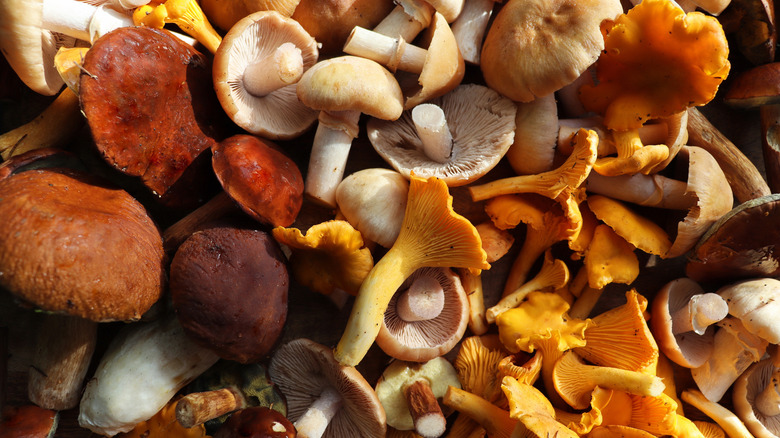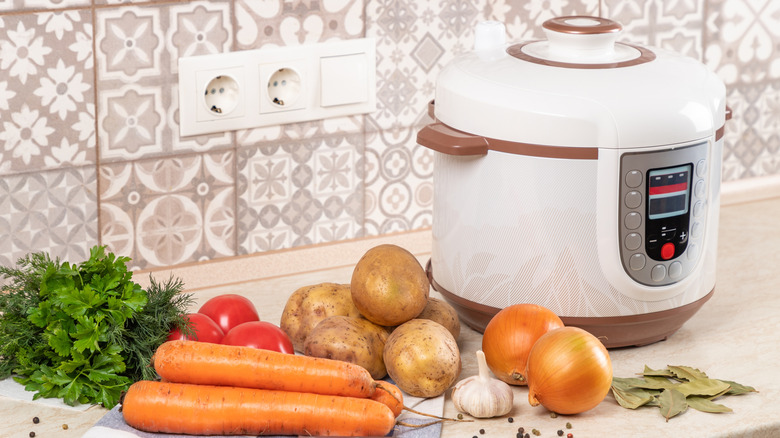8 Pro Tips You Need For Making Vegetable Stock From Scratch
Stocks and broth are culinary staples that provide a flavorful base for savory soups, hearty stews, sauces, and countless other dishes. They're made by simmering chicken, beef, or fish along with a mix of vegetables and herbs in water. As the stocks cook, the water absorbs the flavor from ingredients and many of the vitamins and minerals they contain.
You might be surprised to learn that stock and broth are technically not the same thing. Broths are typically made with vegetables and meat if you're making chicken or beef varieties. Bones are added to the mix when making stock. Despite their differences, the terms are often used interchangeably to describe these flavorful liquids. Vegetable stock is particularly versatile. You can use it as an ingredient to bolster other recipes or as a tool to thin out soups without losing flavor.
Homemade stock has been a staple in my kitchen throughout my career as a personal chef. Many of my clients were on special diets due to health conditions or allergies, and making stocks and broths from scratch was essential. It gave me complete control over the ingredients I used so I could ensure the soups and sauces I made were safe options for my clients. If you're ready to ditch store-bought cartons and embrace the satisfaction of making stock yourself, these essential tips will set you up for success.
Start with the right vegetables
Choosing the right vegetables is key to preparing a flavorful broth, and not all veggies are a good option. Your goal should be to build a broth that is tasty and balanced in flavor and you'll have the best results with quality, fresh vegetables. Broth should start with the three vegetables of mirepoix, a mix of onions, carrots, and celery that provides the foundation of flavor to so many recipes. These and other aromatics, the vegetables, herbs, and spices that help build depth of flavor, enhance your stock, infusing it with their flavor and aromas.
In addition to mirepoix, vegetables like shallots, garlic, leeks, and corn cobs — along with herbs like parsley and thyme – can help you create a balanced base for your vegetable stock. Add vegetables with strong flavors with caution as they can overpower the stock. You should also steer clear of vegetables in the cruciferous family, like broccoli, cauliflower, and cabbage for the same reason.
I like to keep it simple when making my own vegetable stock, but if I'm making it to use in a specific recipe I add ingredients that will work well with the final dish. If my vegetable broth is headed for a pot of spicy soup, I'll toss in half a jalapeno — or a few drops of soy sauce for recipes like this Vegetable Chow Mein Noodle Soup. Pick your vegetables with care and you'll have stock that is versatile and delicious.
Put vegetable scraps to use
If you want to build a vegetable stock that's full of flavor and minimize waste at the same time, start saving your vegetable scraps. After you chop and peel your veggies, you can add those leftover bits and bobs to your stock and simmer them into something delicious. Adding them to your stock pot is one of many ways to use up your vegetable scraps and you can feel good about reducing the amount of waste in your kitchen.
The easiest way to save your scraps is to put them in a resealable plastic bag and keep it in your freezer. It's become second nature for me to separate the good scraps from the bad and drop them into the freezer bag as I cook. I use a gallon-sized freezer bag, and once it's full I'm ready to make stock. You can use a smaller bag for a smaller batch of broth. Save at least 4 cups of scraps before you give it a try.
Don't forget the skin when adding veggie scraps to your freezer bag. Both onion and garlic skins are surprisingly full of flavor when they're simmered in broth. Carrot peels are also a great way to build flavor in your stock. Make sure you're only adding scraps from vegetables that work well in stock. Even the tiniest pieces of some veggies can overpower your stock or give it a bitter taste.
Brown the veggies
One way to elevate your vegetable broth is to sweat or brown your veggies before you use them to build your stock. While you can make a perfectly delicious vegetable stock starting with raw vegetables, the caramelization that develops during cooking will give your stock more flavor.
Sweating your vegetables is the speedier option. If you're wondering what it means when a recipe says to sweat your vegetables, it refers to the art of cooking your vegetables in a little oil until they soften, but don't brown. Sweating not only affects the vegetables' texture by causing them to soften, but it also intensifies the vegetables' flavor and causes any juices inside to bubble to the surface, making the veggies look like they're sweating.
Roasting the vegetables takes a bit longer, but it further enhances the flavor. The high heat required for roasting causes caramelization that browns the veggies and alters their natural sugars. It gives them a savory, nutty flavor that will only improve the taste of your vegetable stock.
Use lots of mushrooms
To build a vegetable stock with the most flavor, be sure to add mushrooms to your stock pot. Mushrooms are known for adding umami taste to recipes they're added to. Typically described as meaty or earthy, umami is one of the five basic tastes. Origins of the word umami date back to the early 20th century, but it wasn't officially recognized as the fifth taste until the early 2000s. Mushrooms are jam-packed with umami, and using them to make vegetable stock will infuse their savory goodness directly into the stock.
When choosing mushrooms, keep in mind that darker mushrooms contain more umami flavor. Shiitake or portobellos are excellent choices. While you can add them to your stock raw, cooked or dried mushrooms will pack your vegetable broth with even more umami flavor. Simply add mushrooms to your stock with the rest of your ingredients, but be sure to taste them first and give them a rinse if they're dirty or gritty.
Add tomatoes
Well-balanced flavors are the key to building a delicious homemade vegetable stock. While the aromatics provide a savory flavor, and mushrooms provide the umami, it's important to add ingredients that will round out the stock's flavor profile. Tomatoes are an excellent way to give your stock a vibrant flavor. Their natural acidity will brighten the stock, providing a delicious counterbalance to the other ingredients.
You can add fresh tomatoes to your vegetable stock, but for maximum flavor reach for tomato paste. Tomato paste is made by cooking tomatoes down, straining them, and then cooking them again. The result is a thick paste that serves as a tomato concentrate, giving a powerful tomato flavor to anything it's added to. You can experiment with the amount of tomato paste you add to your vegetable stock, but start with one tablespoon of tomato paste for every quart of stock you're making.
In addition to extra flavor, tomatoes will also give your vegetable stock a deeper color and a nutrition boost. They're a good source of vitamin C, potassium, and folate, in addition to the antioxidant lycopene, which is believed to combat cancer and heart disease.
Skip the heavy seasonings
Going light with the seasonings might seem counterintuitive to building a flavorful broth, but too much seasoning can give your broth a strong flavor that isn't as versatile. Homemade vegetable broth can be used for a variety of purposes in the kitchen so it's important to keep it relatively neutral in flavor. Adding too much seasoning (or seasonings with exceptionally strong flavors) can limit the way you can use your stock. Keeping it simple when it comes to seasonings is the best way to go.
Seasonings like salt, pepper, herbs, and spices are the foundations of flavor for most recipes. As a cooking instructor, I've taught students to lean heavily on them to enhance their recipes for maximum flavor. This philosophy has led to many delicious dishes, but the opposite is true when making vegetable stock from scratch. Stocks are typically used as an ingredient in other recipes and are seasoned as part of the final dish, so remember to go easy on the seasoning when making your broth.
Get the cooking time right
Getting the cooking time right is crucial when making vegetable broth from scratch. The goal is to simmer it long enough to extract the maximum flavor from the vegetables without overcooking, which can lead to a bitter broth. When you think of making a meat-based stock, like chicken or beef, simmering for hours at a time is likely what comes to mind. Those stocks require a long cooking time to extract the gelatin from the bones, which is what gives the stock its viscosity. Vegetable broth doesn't require as long of a cooking time because there are no bones involved.
Even without the bones, it is possible to over- or undercook your vegetable stock. Undercooked vegetable stock will be flavorless, while simmering for longer than necessary won't impart any additional flavor. Your stock should be ready for use after 45 minutes to an hour of simmering. Once the hour's up, your stock is ready to use. You can reduce it further after straining out the vegetables to intensify its flavor even more.
Use your slow cooker or pressure cooker
No one can deny the convenience factor small appliances like slow cookers and pressure cookers bring to the kitchen. They can transform complicated recipes into a few simple steps, and pressure cookers can put a significant dent in the time it takes to prepare them. While you might be tempted to only pull them out of your pantry for recipes like roasts, stews, and soups, slow cookers and pressure cookers can also make homemade vegetable stock easy work. This is especially true if making broth from scratch seems like more effort than you're willing to put in.
Making stock in your slow cooker couldn't be easier. Simply drop all of your prepped ingredients into the slow cooker, set it, and let the slow cooker magic take place. Once it's done, strain it and your broth is ready to go. If you're using vegetable scraps from the freezer, you only have to empty the bag into the slow cooker and add water. You can produce a stock that tastes like it simmered for hours in a matter of minutes with a pressure cooker. Some will even allow you to saute the veggies in the pressure cooker before you seal it.








